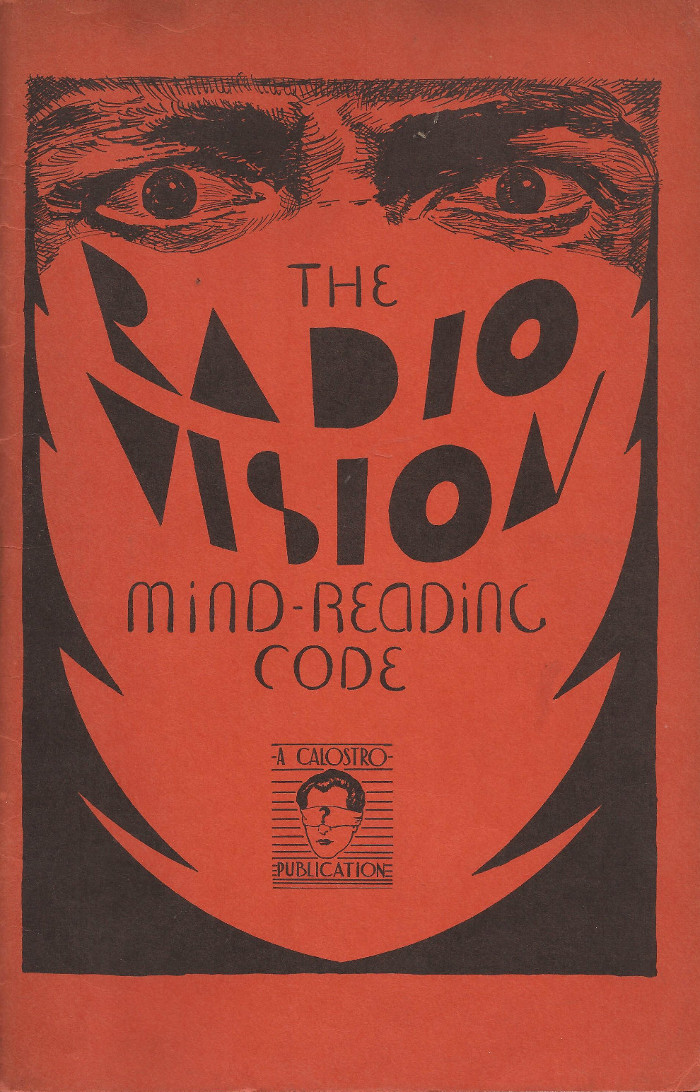Calostro: The New Radio-Vision Mind-Reading Code (1940)
Filed under book | Tags: · code, magic, telepathy

“This is the book by Calostro (Ralph W. Read, Ralph Wesley, 1882-1952) on the two person mind reading code. The verbal code act fully explained enabling you to transmit almost anything at all to your assistant. Numerals, letters, birthdates, Zodiac Signs, Lucky Numbers, Common Articles, First Names, Last Names, Coins and Paper Money, Special Tests for wathces, newspapers, books, and letters, Playing Cards, Titles and Professions, Animals and Birds, Sports, Countries and Nationalities, Organizations and Societies, Clubs, Emblems, Metals, and even Pictures and Drawings.” (source)
Publisher Calostro Publications, New Jersey, 1940
44 pages
commentary (Chris Woodyard)
author’s page at Magicpedia
Erkki Huhtamo, Jussi Parikka (eds.): Media Archaeology: Approaches, Applications, and Implications (2011)
Filed under book | Tags: · cinema, computing, machine, media, media archeology, media theory, psychoanalysis, technology, telepathy

“This book introduces an archaeological approach to the study of media – one that sifts through the evidence to learn how media were written about, used, designed, preserved, and sometimes discarded. Edited by Erkki Huhtamo and Jussi Parikka, with contributions from internationally prominent scholars from Europe, North America, and Japan, the essays help us understand how the media that predate today’s interactive, digital forms were in their time contested, adopted and embedded in the everyday. Providing a broad overview of the many historical and theoretical facets of Media Archaeology as an emerging field, the book encourages discussion by presenting a full range of different voices. By revisiting ‘old’ or even ‘dead’ media, it provides a richer horizon for understanding ‘new’ media in their complex and often contradictory roles in contemporary society and culture.”
Publisher University of California Press, Berkeley, CA, 2011
ISBN 0520262743, 9780520262744
x+356 pages
Reviews: Simone Natale (Canadian Journal of Communication, 2012), Sarah Lugthart (TMG, 2012), John Potts (Screen, 2013), Michael Goddard (Journal of Visual Culture, 2013), Swagato Chakravorty (Senses of Cinema, 2013), Astrid Mager (Information, Communication & Society, 2013).
PDF (updated on 2021-4-9)
Comment (1)Joan Broadhurst Dixon, Eric J. Cassidy (eds.): Virtual Futures. Cyberotics, Technology and Posthuman Pragmatism (1998)
Filed under book | Tags: · artificial intelligence, body, body without organs, chaos theory, cybernetics, cyberspace, deterritorialization, internet, simulation, technology, telepathy

“Virtual Futures explores the ideas that the future lies in its ability to articulate the consequences of an increasingly synthetic and virtual world. New technologies like cyberspace, the internet, and Chaos theory are often discussed in the context of technology and its potential to liberate or in terms of technophobia. This collection examines both these ideas while also charting a new and controversial route through contemporary discourses on technology; a path that discusses the material evolution and the erotic relation between humans and machines. Including essays by Sadie Plant, Stelarc and Manuel de Landa, the collection heralds the death of humanism and the rise of posthuman pragmatism. This collection provides analyses by both established theorists and the most innovative new voices working in conjunction between the arts and contemporary technology.”
Keywords and phrases
Neuromancer, telepathy, cybernetic, Freud, body without organs, pleasure principle, deterritorialization, Lyotard, postmodern, fascism, cyborg, cyberspace, metaphysic of presence, Hebrew alphabet, Talmud, Cybergothic, Habiru, University of Warwick, pictographic, schizoanalysis
Publisher Routledge, 1998
ISBN 0415133793, 9780415133791
125 pages
PDF (updated on 2012-8-9)
Comment (0)
